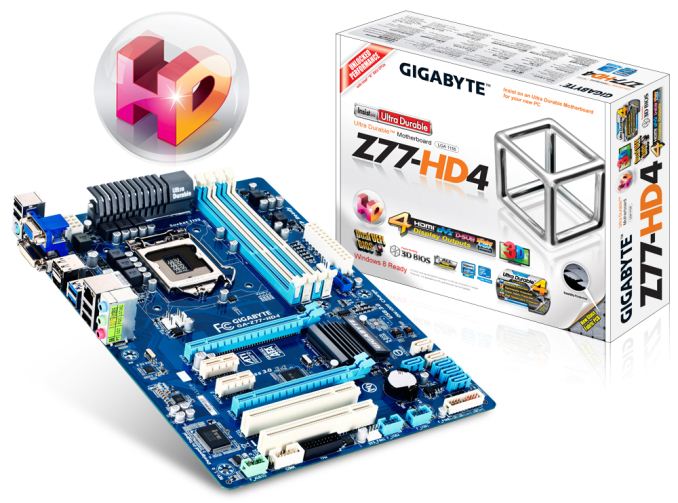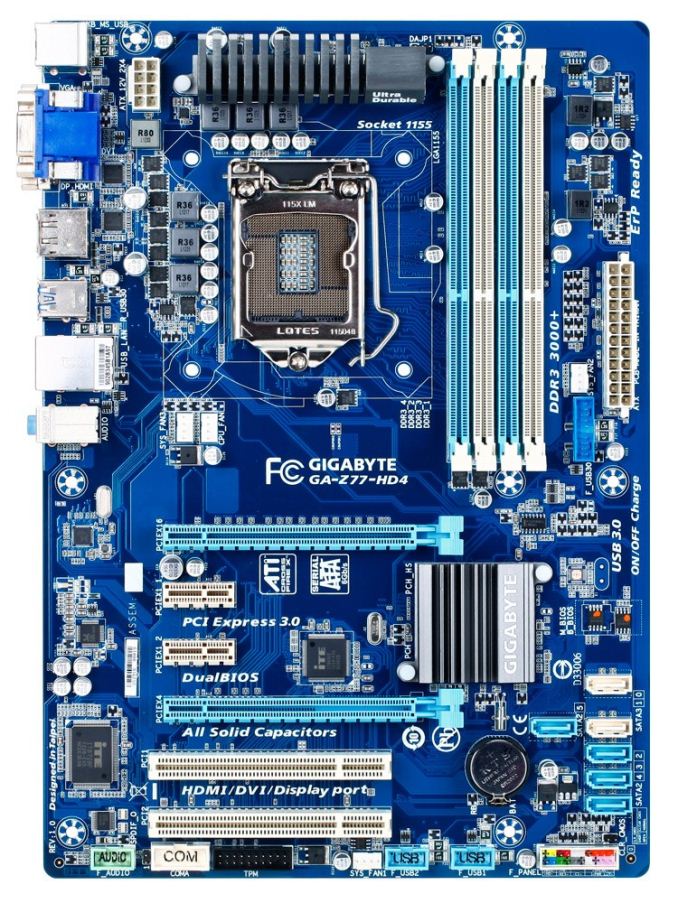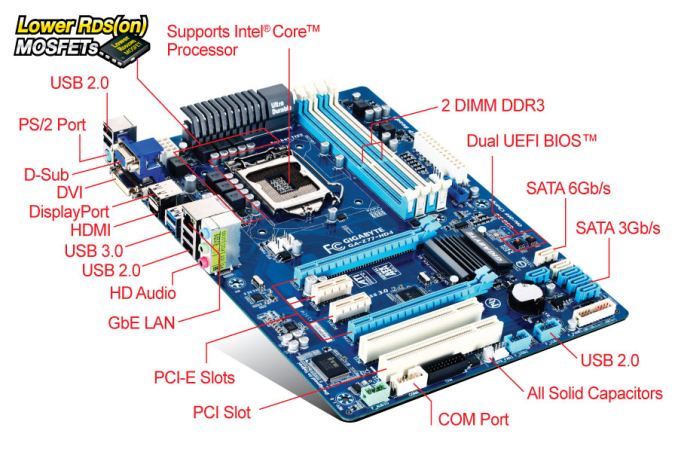Gigabyte Z77-HD4 Review
by Ian Cutress on May 19, 2013 10:00 AM EST- Posted in
- Motherboards
- Gigabyte
- Z77

While most of the focus for motherboards is on the big models, what happens when we get down to the lower price points? If you want a basic ATX Z77 motherboard with all the IGP video outputs, Gigabyte has you covered at $120 with the Z77-HD4. At this price point we are dealing with an overclockable chipset designed for a single GPU but still has basic audio and all Z77 features. Typically using HDMI invokes a small price premium due to the licensing, and in a budget board stripping down everything is the number one priority. Gigabyte wanted to have that stripped down Z77, but also offer a full video output set without pushing the price up too high.
Gigabyte Z77-HD4 Overview
When writing a review, we go to great lengths to be unbiased in our analysis – I give no favor to branding on the box. An issue comes along when dealing with a sub $125 motherboard like the Z77-HD4 because we simply do not do enough in this price range. Is it a good price? I honestly do not know. There are a lot of motherboards in that price range and below, meaning that the Z77-HD4 will be a focus on two fronts – if you need a feature that Z77 provides that H7x, Q7x or B7x does not, and you want any of the digital IGP ports.
The points that make a user want a Z77 motherboard will be in the overclocking, the PCIe lane allocation, and the combination of RST/SRT. If you do not need overclocking, then H77/Q77 will be the port of call. There are a few B75 motherboards south of $70, but you lose overclocking, RAID, RST and SRT.
The Gigabyte Z77-HD4 then covers the basic Z77 platform for a single GPU user. We get six SATA ports from the chipset (two SATA 6 Gbps, four SATA 3 Gbps), three fan headers, a PCIe layout for an x16 GPU, an extra x4 device, and a pair of PCIe x1 and PCI devices – the latter via a controller. Like almost all Gigabyte motherboards we get a TPM header and a COM port as well. Audio is in the form of a Realtek ALC887, Ethernet via a Realtek 8111E, USB 3.0 from the chipset and a full complement of DIMM slots.
Overall the board performed reasonably well, even while overclocking. Performance on Gigabyte boards has been getting more and more efficient as the BIOSes mature, giving the Z77-HD4 some higher scores than expected. Clearly there are some draw backs with cheaper motherboards – in this case the Windows 7 posting time for a dual GPU setup was nearer 20 seconds than 10 seconds, the DPC Latency suffered from spiking in normal usage and the audio testing was way down compared to an ALC898 or enthusiast variation therein. In terms of layout, using the PCIe x4 from the chipset for a dual slot GPU will reduce the number of SATA ports available.
But for a board that works, overclocks, supports 32GB of high speed memory and a base number of Z77 devices, the Gigabyte Z77-HD4 does hit those checkpoints.
Visual Inspection
As this is our first real budget board of the Z77 range (something we are going to rectify with Haswell), it is hard to put down on paper what to expect. Essentially, I expect the chipset defaults, though as seen below, in order to keep costs down we only get three audio outputs (due to the codec), and SATA ports coming out of the motherboard. Also note that the Z77-HD4 is thinner than normal ATX, and is missing the far end screw holes.
The socket area is a little different to most of what we have reviewed in the past, as the VRM heatsink is above the socket and comparatively quite far away from the Intel minimum recommended distance, giving plenty of room for large CPU coolers. Unlike the G1.Sniper M3 reviewed previously, we get a full 8-pin CPU power connector for the CPU, although with few phases it will be interesting to see how well such a budget board overclocks. Around the CPU we have access to three fan headers for fans – two 4-pin headers to the bottom left of the socket, and another beside the 24-pin ATX power connector. The other 4-pin header is on the bottom of the board.
Moving clockwise around the board, we have a full complement of DIMM slots, and as expected these are latched on both sides rather than the single sided latch system that is emerging on some motherboard manufacturers’ ranges. Beside this is the 24-pin ATX power connector, one of the aforementioned fan headers, and a USB 3.0 port. Moving down is our chipset heatsink – small enough to cover the chipset but not connected to any other heatsink. The SATA ports are all coming out of the board, with two SATA 6 Gbps in white and four SATA 3 Gbps in blue. Even though the second full PCIe slot could cause some of the SATA ports to be blocked if large GPUs are used, this second PCIe only runs at PCIe x4 from the chipset, and although CrossFireX compatible, is not suggested for gaming GPU usage.
Along the bottom of the board we have our front panel connectors, two USB 2.0 headers, a fan header, a TPM header, a serial port header and the front panel audio header. The PCIe slots are arranged in an x16, x1, x1, x4, PCI, PCI layout. Seeing two PCI slots on a Z77 motherboard is not as common as it once was, with the PCI standard no longer included as part of the chipset specifications (and requires a controller). However it is cheap, and users can purchase PCI to USB or PCI to Firewire cards if extra functionality is needed.
The main point that Gigabyte marketing are trying to sell with this motherboard is the use of HDMI certification on a cheap product. Normally products in this price range are limited to D-Sub and DVI-D, and there is apparently a market for HDMI on board. Gigabyte also pairs this with the DisplayPort connector. Aside from the four video outputs, we also have four USB 2.0 ports, a combination PS/2 port, two USB 3.0 ports, a Realtek gigabit Ethernet port, and three audio jacks from a Realtek ALC887 chip.
Board Features
| Gigabyte Z77-HD4 | |
| Price | Link |
| Size | Slim ATX (30.5cm x 21.5cm) |
| CPU Interface | LGA-1155 |
| Chipset | Intel Z77 |
| Memory Slots |
Four DDR3 DIMM slots supporting up to 32 GB Up to Dual Channel, 1066-2800 MHz |
| Video Outputs |
D-Sub DVI-D HDMI DisplayPort |
| Onboard LAN | Realtek 8111E |
| Onboard Audio | Realtek ALC887 |
| Expansion Slots |
1 x PCIe 3.0 x16 1 x PCIe 2.0 x4 2 x PCIe 2.0 x1 2 x PCI |
| Onboard SATA/RAID |
2 x SATA 6 Gbps (Chipset), RAID 0, 1, 5, 10 4 x SATA 3 Gbps (Chipset), RAID 0, 1, 5, 10 |
| USB |
4 x USB 3.0 (Chipset) [2 back panel, 2 onboard] 8 x USB 2.0 (Chipset) [4 back panel, 4 onboard] |
| Onboard |
2 x SATA 6 Gbps 4 x SATA 3 Gbps 1 x USB 3.0 Header 2 x USB 2.0 Headers 4 x Fan Headers 1 x SPDIF Output Header 1 x Serial Port Header 1 x Clear_CMOS Header 1 x TPM Header |
| Power Connectors |
1 x 24-pin ATX Power Connector 1 x 8-pin CPU Power Connector |
| Fan Headers |
1 x CPU 3 x SYS |
| IO Panel |
1 x PS/2 Combination Port D-Sub DVI-D DisplayPort HDMI 2 x USB 3.0 4 x USB 2.0 1 x Intel GbE 1 x Optical SPDIF Out 3 x Audio Jacks |
| Warranty Period | 3 Years |
| Product Page | Link |
For a cheap board, we are going to get the basics and not a lot else. As mentioned previously, the main draw for this motherboard is the inclusion of all four video outputs. We get a fairly cheap audio codec used to bring costs down, but in my opinion I would still like motherboard manufacturers to place power/reset/Clear_CMOS buttons as well as a two digit debug in order to diagnose issues. Users who want a PCIe GPU, an x1 WiFi card, a PCIe RAID card and a pair of PCI devices will be well catered. Ultimately this board is probably aimed at the internet café market in China, where cheap and cheerful rule the roost, although I cannot see why they would want overclockable motherboards, unless it is used as a point of advertising.














63 Comments
View All Comments
Grok42 - Monday, May 20, 2013 - link
I am extremely proud of the Anandtech readers that commented here. I typed out what would have been the first post on this review and at the last minute canceled it. I thought it too harsh and possibly wasn't fair to post it on a specific review when in fact it was about the editorial leaning of Anandtech as a whole.Go read the About page and you'll see this site is dedicated to reviewing computers, phones and components from consumer to enterprise. However, as of late it seems that all the reviews on the consumer side are completely bent toward some stereo-typical gamer building water cooled overclocked triple GPU gaming rigs. While nothing wrong with these types of builds and they are fun to read and think about, there has to be some respect for those that want other builds. I just spent $1500 building a mITX gaming and workstation rig with a core i7 3770. It has a $300 GPU, $300 CPU, $350 SSD, $120 case and a $80 MB running a stock Intel cooler. I couldn't be happier and NEVER intend to overclock it. As strange as my choices are, I bet I'm closer to 90% of the readership than a $600-$900 dual or triple GPU and $200 MB rig that seems to be implied as required equipment around here.
The worst of it is that there is a huge movement to smaller, cooler and quieter rigs that doesn't seem to have a voice on the inside at Anandtech. A full ATX tower running 3 GPUs and 5 HDDs is no longer the sought after box for a growing base of enthusiasts. The small cool looking mITX that can also play games is what's hot.
jabber - Monday, May 20, 2013 - link
Yes indeed, also quite a few of us here are over the age of 30 so a lot of the toys and whistles and flashing lights don't really appeal so much.We prefer durability, stability and value for money more.
I think a lot of the high-end manufacturers have forgotten that a lot of their consumer base has got a lot older. Buying boxes with dragons and wonderwomen on them doesn't have quite the appeal it might have 15 years ago.
Razorbak86 - Monday, May 20, 2013 - link
LOL. Age doesn't have a thing to do with it. Money often does though. Remember, this site is oriented towards enthusiasts first. So don't hate because others like more expensive components than you can afford.kmmatney - Monday, May 20, 2013 - link
It not about being able to afford the high end stuff - but why pay %100 more for maybe a 10% gain in performance. I like to see all the reviews - high and and low end, so this review was great. At the end of the day, the parts I buy will be whatever gives the best bang-for-buck, at the performance level (and noise level) I can accept. I don't hate the reviews of high end parts, but I want reviews like this to balance things out.Wall Street - Monday, May 20, 2013 - link
It isn't even for a 10% gain in performance. I, and a many users like me, are not going to use more than one SSD, aren't going to use more than one GPU, aren't going to use more than a couple of USB 3.0 ports (I don't own a single USB 3.0 device), won't overvolt/aggressively overclock and I even use the digital audio out on top of that (although the analog audio on this board is very disappointing).In that case, $120 boards like this are nearly identical in performance to one of the top end offerings. I think that, in thinking this is a low end offering, Ian misses where the sweat spot of the market is entirely. $120 motherboards are solidly midrange. You can get a low-end motherboard for less than $70 on Newegg. Compared to what Dell uses in its desktops, this board is feature packed!
jabber - Monday, May 20, 2013 - link
It does actually. When you get a bit older you find out.Enjoy your youth while you have it!
jabber - Monday, May 20, 2013 - link
Oh and the PC enthusiast market is slowly diminishing. Sites like this need to diversify to appeal to types that don't think the peak of a good day is spent running Prime95 on a new PC for 24 hours.Rob94hawk - Monday, May 20, 2013 - link
Anyone want to explain to me why they're still putting USB 2.0 and SATA 3Gb/s when everything's backwards compatible?lever_age - Monday, May 20, 2013 - link
Every SATA 6 Gb/s and USB 3.0 port is handled by the Z77 chipset on that board. Actually, all the SATA 3 Gb/s and USB 2.0 are as well.If you want more of the faster SATA and USB, you need to pay for extra 3rd-party controller chips, which increases board costs. It's a legitimate form of product differentiation to leave those out on the cheaper products. But supposedly 8-series chipsets with Haswell (or at least most of them?) will support six SATA 6 Gb/s and six USB 3.0 natively.
jabber - Monday, May 20, 2013 - link
I find USB3 still isn't quite a solid in terms of "it just works" like USB2 does. I think the USB3 chipsets still haven't got bedded down in the OS as solidly as USB2.Give it another year or two and it should be...I hope.